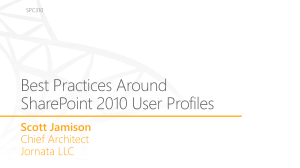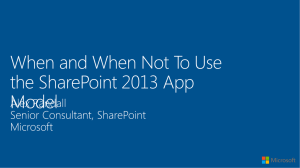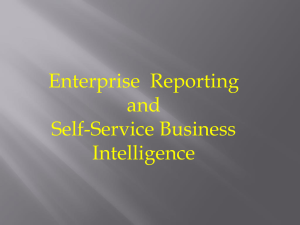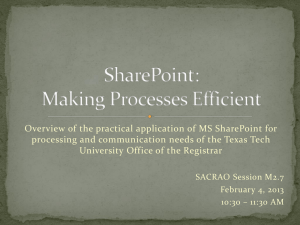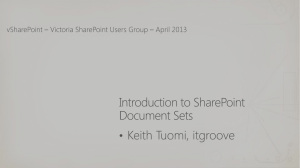BOWERS_EngageTheBusiness_SPSat_STL_2013
advertisement
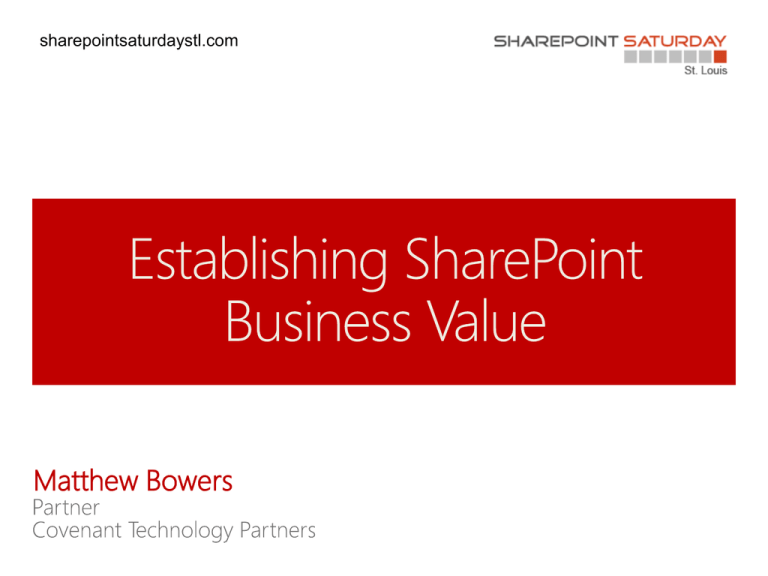
sharepointsaturdaystl.com Matthew Bowers http://spsaturday.cloudapp.net 2 | SharePoint Saturday St. Louis 2014 http://spsaturday.cloudapp.net 3 | SharePoint Saturday St. Louis 2014 Bio • Matthew Bowers – mbowers@mailctp.com – Covenant Technology Partners – Partner – Infrastructure Architect (SharePoint and CRM) – Project Manager – Practice Manager (CRM and Cloud) – 12 years CIO / CTO experience – 21 plus years in corporate IT Engage the Business! Why Does SharePoint Matter? • Does SharePoint Matter? SharePoint Doesn’t Matter! • Business Matters! • Why is a business in … well… business? • What is the relationship between – Risk – Value • Will SharePoint increase value and decrease risk? Ask Yourself Some thought provoking questions • Is this an IT or a business project? • Who “owns” the project? • Who “owns” the processes? • Who will “own” the environment when complete? • How will management of the environment take place? Other questions… • • • • How will you measure success of the project? What are your KPIs for success? Why do projects fail? Why SharePoint? How Will SharePoint Support The Business? • • • • • • • People Devices Social Cloud? Control? Governance? Security? Other areas? What are people doing today, that they were not doing in 2006? 2007? Consumerization of IT • What is the role of this trend in SharePoint adoption? • Who drives? • What drives your business? • What drives requirements? • Understanding what has made this important • Understanding why it is relevant Why Does SharePoint Fail • • • • • • • • • • Politics Not knowing what SharePoint is Lack of information and knowledge management skills Vision, the business case, and measuring success Executive support User adoption Individual choices derail SharePoint initiatives Information Management Defining requirements Technical skills Why Does SharePoint Fail • • • • • • • • • • • No Vision Statement False expectations Showcasing features instead of building solutions Lack of proper planning Lack of proper staffing Undefined success measurement No adequate support Ambiguous requirements Poor stakeholder involvement Poor communication Lack of governance Why Does SharePoint Fail Almost ALL of the above go back to 2 broad categories • Business engagement • User adoption Failed Approaches • Field of Dreams • Network Nazi • Usually when IT is driving! How To Engage the Business • • • • • • • • Proper project planning Requirements gathering Business analysis and process mapping Steering committee Working committees Departmental Working groups Governance committee Establish BUSINESS VALUE Establishing Business Value Methodologies Engaging the Business through approaches to the project • Agile • Six Sigma / Lean • Kaizan • JAD • Other quality initiatives • Establishing the Business Case What is a Business Case • A business case captures the reasoning for initiating a project or task. • Often presented in a well-structured written document • May also sometimes come in the form of a short verbal argument or presentation. • The logic of the business case is that, whenever resources such as money or effort are consumed, they should be in support of a specific business need What is a Business Case • Business cases can range from comprehensive and highly structured, as required by formal project management methodologies, to informal and brief. • Information included in a formal business case could be the background of the project, the expected business benefits, the options considered (with reasons for rejecting or carrying forward each option), the expected costs of the project, a gap analysis and the expected risks. Why use a Business Case? • SharePoint like every business technology is an investment • Before making an investment you should always know your expected return • Business Case Formulas: – Net Present Value (NPV) – Return on Investment (ROI) – Rate of Return (ROR) – Internal Rate of Return (IRR) – Cost Benefit Analysis Why use a Business Case • Focus requirements/scope on capabilities that will deliver Value • Useful for managing scope change • Beginning of the Organization Change Management Process – Ensure Users will use the system • Level of Precision – Depends on Maturity of the Plan – Organization Culture – what is your culture? – Make and document assumptions SharePoint Business Scenarios • The business doesn’t care about SharePoint • Intranet – Collaboration – Communication – Content Management/Search – BI – Forms/Workflow • Extranet • Public Facing Websites SharePoint Business Scenarios • Upgrade – Functional Enhancement – Consolidation • Point Solutions – HR Portals – M&A Portals – Board Portals – Product Development Portals – Workflow Solutions Identifying the Business Problem • • • • • • • • • • • Enterprise Search End user adoption Desire to make portal part of the virtual desktop strategy Navigation and ease of use Communication Collaboration Employee Information and organizational structure Forms and paper reduction Centralized vs. Distributed Content Management Document and Content Management Reporting Examples • Search – in the legacy intranet, people search did not work. Could not locate information about specific people. Document search was inefficient. • End user adoption – web trends statistics showed that less then 10 percent of the organization ever came to the site (due to most of the reasons cited as the problem) • Navigation – difficult to navigate system of pages with numerous links to other pages. No cohesive information architecture to define the experience Examples • Virtual desktop – in order to drive end user adoption, as well as making SharePoint part of the over all VDI strategy. • Collaboration –in the legacy environment, non existent. No document repository, workflows, check in or out etc. • Employee information – desired a comprehensive, centrally located environment for finding employee information and understanding organizational structure Examples • Communication – no central or focal point for disseminating news and information. Driving the right content to the right audience at the right time. • My Sites • Social Media – organization embracing social media Why SharePoint? Gartner Quadrant for Portals SharePoint Strengths • Majority are internal facing and departmental, focus on collaboration • Initiatives center on Microsoft technology stack (BI, CRM, other integration) • Microsoft sweet spot (collaboration, integration, other stack components) • High prevalence in enterprises puts rival vendors in position to accommodate as well as compete • 2013 wave shows great promise Where to Begin - Requirements Requirements • • • • • Business Technical – security, scalability Functional – business process flow UX – user interface, design Content SharePoint Solution Components • Usability – Branding – Navigation and Taxonomy • Content – Web Content – Documents and Records – Digital Assets • Functions • Infrastructure – Hardware – Software – Security Information Architecture/Taxonomy Intranet Home Page Departments Locations Business Units HR Branches Retail IT Processing Center Commercial Finance Buy vs Build • SharePoint is an Application Template with Components • Five ways to do anything in SharePoint • Commercially available plug-in components 36 Component Addins • • • • Metalogix Nintex K2 others Risk Analysis/Sensitivity Analysis • Risk Assessment – Understand and manage the risks from the beginning • Sensitivity Analysis – Illustrates the sensitivity of model results to model assumptions – Assumptions: Hurdle Rate, Adoption Rate, Rate of KPI Improvements, Deployment Cost Estimates – Outputs: Payoff period, NPV, ROI 1 yr ROI = %20 Return 1 yr ROI = %10 1 yr ROI = %5 Time Positive project return given a range of potential costs and benefits will ease customer concerns that an analysis is over aggressive Key Metrics By Stakeholder Stakeholders CFO BDM CIO Metrics Desirable Results NPV - Net Present Value $ > Zero Payback Period Ideally < 12 months IRR - Internal Rate of Return % > Company Hurdle Rate Any Customer KPIs Company Specific TCO Lower Beware unreasonable results: • IRR, ROI >500% • Instant Payback Beware undesirable results: • IRR < hurdle rate • ROI < 0% • Payback > 24 months Business Process Value Modeling: Best Practices • Study one process at a time – Survey to understand best opportunities • Prerequisite: Work directly with the end user • Physically map business process metrics to get buy-in for process change • Business managers are the source for pains and benefit equation variables • Pain/KPI discussion drives business value versus productivity • Keep equations simple • Estimate process change metrics and then present them for approval if you can’t get the numbers you need – Get buy-in to defend numbers before presenting It Starts at Measurable Pains • Key Performance Indicators (KPIs) are measurable pains • Pains have no quantitative value if they cannot be measured Common Reasons For Pain Missed Deadlines Overflowing Pipeline Insufficient Staff Competition Budget Constraints KPIs Revenue Employee Utilization Customer Retention Number of Customers Poor Cash Flow Cost Analysis: Best Practices • Group costs into buckets – • • For example, desktop and server solutions usually have different cost buckets The key to effective costing is identifying the time spent on each activity - Work Breakdown Structure Recognize costs that should not be included in analysis – Costs that would be incurred anyway • e.g.., normal hardware refresh – Costs not directly related to the project • e.g., additional system changes – Costs already incurred (sunk costs) • e.g., operating system upgrades already completed Cost Analysis: Best Practices – Costs already incurred (sunk costs) • e.g., operating system upgrades already completed • Be sure to include all components • Always perform “what-if” analysis • Like benefits, get buy-in to defend numbers before presenting business value study Common Costs Elements Cost Element Info Sources Example Calculation Software MS Account Manager Licenses * cost of license Hardware Vendor/Partner Hardware components * cost Planning Time Vendor/Partner IT hours * cost per hour Pilot Program Vendor/Partner Cost of labor, hardware, software Development Time Vendor/Partner Partner cost + IT hours * cost per hour App Testing/Remediation Vendor/Partner IT hours * cost per hour Image Engineering Vendor/Partner IT hours * cost per hour Installation Time Vendor/Partner IT hours * cost per hour Employee Downtime Vendor/Partner Install time * cost per hour Training Vendor Training class expense + employee training time Support Costs Vendor/Partner IT hours * cost per hour Ongoing Maintenance Vendor/Partner Desktop & Server The Cost Line Financial Measures Year 0 Implementation Costs ($764,000) Additional Operating Costs Year 1 Year 2 Year 3 Total ($764,000) ($15,200) ($15,200) ($15,200) ($45,600) Benefits (one-time) $0 Benefits (on-going) $1,279,487 $1,279,487 $1,279,487 $3,838,462 $3,028,862 Net Cash Flow ($764,000) $1,264,287 $1,264,287 $1,264,287 Cumulative Cash Flow ($764,000) $500,287 $1,764,574 $3,028,862 Discount Rate Net Present Value (NPV) NPV per User Payback (months) Internal Rate of Return (IRR) 15% $2,000,000 $4,000 7 150% Value Equations Examples Reduced Operating Cost = Change in work time per unit (hours) X number of units annually X Fully burdened cost/hour = Extra $ Saved Increased Revenue = (Target close rate – Current close rate) X Number of Opportunities X Average Revenue per closed sale X Profit Margin = Extra $ Earned The Benefit Line Financial Measures Year 0 Implementation Costs ($764,000) Additional Operating Costs Year 1 Year 2 Year 3 Total ($764,000) ($15,200) ($15,200) ($15,200) ($45,600) Benefits (one-time) $0 Benefits (on-going) $1,279,487 $1,279,487 $1,279,487 $3,838,462 $3,028,862 Net Cash Flow ($764,000) $1,264,287 $1,264,287 $1,264,287 Cumulative Cash Flow ($764,000) $500,287 $1,764,574 $3,028,862 Discount Rate Net Present Value (NPV) NPV per User Payback (months) Internal Rate of Return (IRR) 15% $2,000,000 $4,000 7 150% Pulling Financial Metrics Together Financial Measures Year 0 Implementation Costs ($764,000) Additional Operating Costs Year 1 Year 2 Year 3 Total ($764,000) ($15,200) ($15,200) ($15,200) ($45,600) Benefits (one-time) $0 Benefits (on-going) $1,279,487 $1,279,487 $1,279,487 $3,838,462 $3,028,862 Net Cash Flow ($764,000) $1,264,287 $1,264,287 $1,264,287 Cumulative Cash Flow ($764,000) $500,287 $1,764,574 $3,028,862 Discount Rate Net Present Value (NPV) NPV per User Payback (months) Internal Rate of Return (IRR) 15% $2,000,000 $4,000 7 150% Value Proposition Low High Yr1-Low Yr1-High Yr2-Low Yr2-High Yr3-Low Yr3-High Benefits Optimize Troubleshooting Increase 1st call resolutions Reduce search time Decision trees Mapping (sorting by distance to pymt cntr) Bookmark/quicklinks to favorites Interteam communication Content management/consolidation Email with customers Trouble shooting Improve Sales Reduce costs Free up dev resources (forms) Virtualization Ease of report generation Enterprise-wide Portal Architecture Shadow IT (One Source & others) Total Benefit $700,000 $800,000 unquantified unquantified unquantified unquantified unquantified unquantified unquantified unquantified $0 $800,000 $950,000 $700,000 $800,000 $800,000 $950,000 $700,000 $800,000 $800,000 $950,000 $30,000 $50,000 $30,000 $50,000 $30,000 $50,000 unquantified unquantified unquantified $250,000 $350,000 $250,000 $350,000 $250,000 $350,000 $0 $1,780,000 $2,150,000 $1,780,000 $2,150,000 $1,780,000 $2,150,000 Costs Hardware Servers Software Microsoft People Infrastructure Setup Application Development Application Support * Total Costs Total Hard Benefit-Cost per Period Breakeven * No net new support costs $5,000 $90,000 $10,000 $40,000 $0 $60,000 $400,000 $750,000 $0 $30,000 $415,000 $970,000 $3,000 $12,000 $3,000 $12,000 $3,000 $12,000 $0 $0 $0 $0 $0 $0 $3,000 $12,000 $3,000 $12,000 $3,000 $12,000 $1,777,000 $2,138,000 $1,777,000 $2,138,000 $1,777,000 $2,138,000 $1,362,000 $1,168,000 $3,139,000 $3,306,000 $4,916,000 $5,444,000 The Business Case is Compelling Thanks to Our Sponsors!


